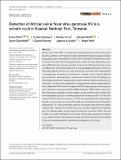| dc.description.abstract | African swine fever (ASF) is a severe haemorrhagic disease of domestic pigs caused
by ASF virus (ASFV). ASFV is transmitted by soft ticks (Ornithodoros moubata complex
group) and by direct transmission. In Africa, ASF is maintained in transmission cycles
of asymptomatic infection involving wild suids, mainly warthogs (Phacochoerus afri canus). ASF outbreaks have been reported in many parts of Tanzania; however, active
surveillance has been limited to pig farms in a few geographical locations. There is an
information gap on whether and where the sylvatic cycle may occur independently
of domestic pigs. To explore the existence of a sylvatic cycle in Saadani National
Park in Tanzania, blood and serum samples were collected from 19 warthogs se lected using convenience sampling along vehicle-accessible transects within the na tional park. The ticks were sampled from warthog burrows. Blood samples and ticks
were subjected to ASFV molecular diagnosis (PCR) and genotyping, and warthog sera
were subjected to serological (indirect ELISA) testing for ASFV antibody detection.
All warthog blood samples were PCR-negative, but 16/19 (84%) of the warthog sera
were seropositive by ELISA confirming exposure of warthogs to ASFV. Of the ticks
sampled, 20/111 (18%) were positive for ASFV by conventional PCR. Sequencing of
the p72 virus gene fragments showed that ASF viruses detected in ticks belonged to
genotype XV. The results confirm the existence of a sylvatic cycle of ASFV in Saadani
National Park, Tanzania, that involves ticks and warthogs independent of domestic
pigs. Our findings suggest that genotype XV previously reported in 2008 in Tanzania
is likely to be widely distributed and involved in both wild and domestic infection
cycles. Whole-genome sequencing and analysis of the ASFV genotype XV circulating
in Tanzania is recommended to determine the phylogeny of the viruses. | en_US |

